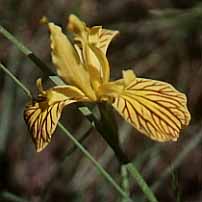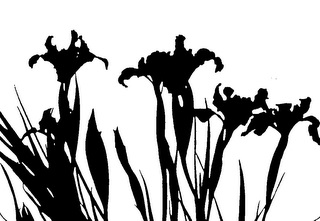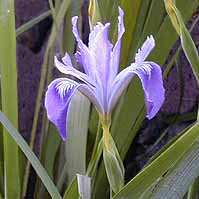 |
Iris innominata
despite its (no name) description is perhaps the most welcome iris
discovery of the depression 1930's, made in the Siskyous by Mrs. John
R. Leach a well-known Portland botanist. With its brilliant gold, it
lent new excitement to iris gardeners and hybridizers alike. White and
purple forms also exist and where the colors overlap, exiting bi color
variations are found. "Burnt Umber" is a hybrid of burnt golden-yellow
flowers with maroon-brown veining and dark gold throats. Proper
drainage is a must for this species (or hybrids involving this
parentage). Partial shade is preferable. The species Iris tenax brings
the Pacific Coast Iris to the northern limit of its range. Tenax refers
to the toughness of the plant, and like douglasiana, its fibers were
used by the native people in the making of ropes, fishing nets and
snares. The very edges of the leaves were separated by thumbnail into
fine silk-like strands, and then laboriously woven together. The
resulting rope was strong and pliable enough to catch deer, hence it
was known as deer rope. This iris is found in prairies and open
coniferous or oak forests from south-central Washington to northwest
California. Gene hardiness born in plants that grow from the coast into
the Cascade range up to 3,500 to 4,000 feet (an environment where
daytime spring temperatures can fluctuate by 50.F). On I-5, near Chehalis, WA. a
clear violet-blue group was brilliantly visible every spring. Imagine
my surprise when I couldn't find the clumps. I couldn't even find the
hills! The Highway had been improved and the very curvature of the
earth removed. These deciduous friends didn't have a chance. An attraction of this species
is the size of the clump itself; seed can be collected from forms under
twelve inches, a trait most useful in rock gardens or in hybridizing
with its more strapping southern cousins. This iris is often found in
clear cuts, or where trees have been removed. Flower size is equal to
other species, and the color in Washington is primarily tones of blue
and lavender-violet. White, cream, and yellow forms are reported, but
are rare. In Oregon (I. Gormanii Piper) is a pale yellow form, and in
Eastern Oregon and WA. we have the buff yellow subspecies I.
klamathensis, well-veined brown or maroon. The Siskiyou subspecies I.
Thompsonii is a beautiful purple, and where these mountain species
overlap, color combinations dance to the full spectrum of their
potential. |


